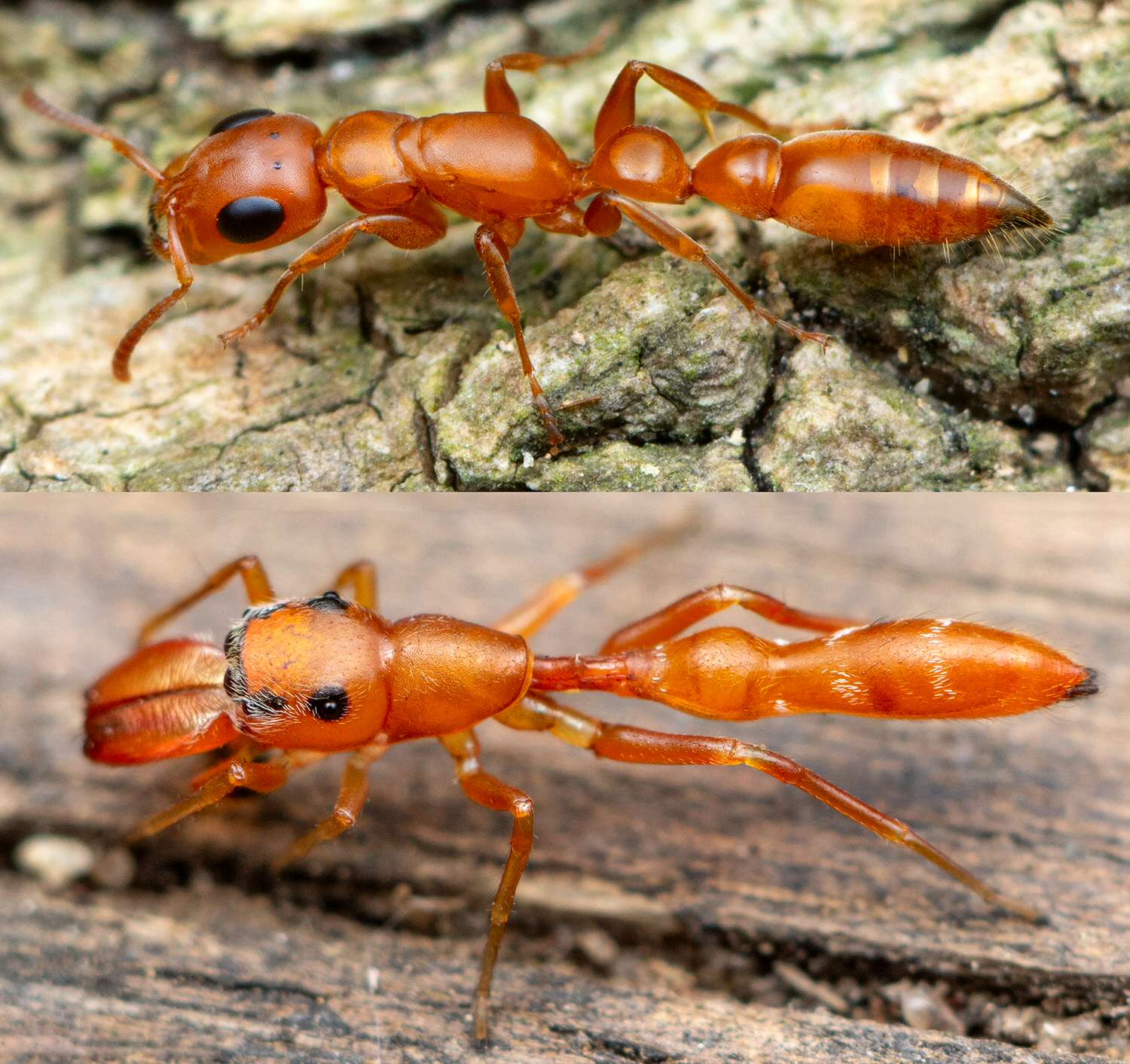|
Aeolothripidae
The Aeolothripidae are a family of thrips. They are particularly common in the holarctic region, although several occur in the drier parts of the subtropics, including dozens in Australia. Adults and larvae are usually found in flowers, but they pupate on the ground. While they normally prey on other arthropods, many feed also on flowers.Mound, L.A. (1977). A new genus of Aeolothripidae (Thysanoptera) from New Zealand and New Caledonia. ''New Zealand Journal of Zoology 4:149-152PDF(''Desmidothrips'') Genus ''Aeolothrips'', which contains about half of all species in this family, mostly live on flowers, although a few species live at ground level as obligate predators of mites. Those that live on flowers are normally facultative predators. '' A. intermedius'' requires floral proteins in its diet in addition to its regular prey of thrips larvae to breed successfully. ''Franklinothrips'' is a pantropical genus of ant-mimicking predators. Genera * '' Aduncothrips'' Ananthakrishnan, ... [...More Info...] [...Related Items...] OR: [Wikipedia] [Google] [Baidu] |
Thrips
Thrips ( order Thysanoptera) are minute (mostly long or less), slender insects with fringed wings and unique asymmetrical mouthparts. Different thrips species feed mostly on plants by puncturing and sucking up the contents, although a few are predators. Entomologists have described approximately 6,000 species. They fly only weakly and their feathery wings are unsuitable for conventional flight; instead, thrips exploit an unusual mechanism, clap and fling, to create lift using an unsteady circulation pattern with transient vortices near the wings. Many thrips species are pests of commercially important crops. A few species serve as vectors for over 20 viruses that cause plant disease, especially the Tospoviruses. Some species of thrips are beneficial as pollinators or as predators of other insects or mites. In the right conditions, such as in greenhouses, many species can exponentially increase in population size and form large swarms because of a lack of natural predators ... [...More Info...] [...Related Items...] OR: [Wikipedia] [Google] [Baidu] |
Franklinothrips
''Franklinothrips'' is a genus of thrips with pantropical distribution. Name The genus name is derived from the surname of entomologist H. J. Franklin, who described thrips taxa in the early 1900s. The thrips genus '' Frankliniella'' is also named after him. Franklin worked at the entomology department of the University of Massachusetts Amherst in the 1930s. Reproduction Most species are apparently bisexual (have both males and females) and occur only in small areas. An exception is ''F. vespiformis'', which is unisexual (mostly females) and occurs in many tropical countries. Only few males were produced during rearing programmes involving ''F. vespiformis''. Mimicry The fast-running females are easily misidentified as ants or bethylid wasps (superfamily Chrysidoidea). Particularly the African species ''F. megalops'' very closely mimics ants in its behavior and body form. Males are less ant-like in appearance. They are smaller, have longer antennae and a less constricted waist ... [...More Info...] [...Related Items...] OR: [Wikipedia] [Google] [Baidu] |
Ant Mimicry
Ant mimicry or myrmecomorphy is mimicry of ants by other organisms. Ants are abundant all over the world, and potential predators that rely on vision to identify their prey, such as birds and wasps, normally avoid them, because they are either unpalatable or aggressive. Spiders are the most common ant mimics. Additionally, some arthropods mimic ants to escape predation (protective mimicry), while others mimic ants anatomically and behaviourally to hunt ants in aggressive mimicry. Ant mimicry has existed almost as long as ants themselves; the earliest ant mimics in the fossil record appear in the mid Cretaceous alongside the earliest ants. Indeed one of the earliest, ''Burmomyrma'', was initially classified as an ant. In Wasmannian mimicry, mimic and model live commensally together; in the case of ants, the model is an inquiline in the ants' nest. Wasmannian mimics may also be Batesian or aggressive mimics. To simulate ants' powerful defences, mimics may imitate ants chemically w ... [...More Info...] [...Related Items...] OR: [Wikipedia] [Google] [Baidu] |
Aeolothrips
''Aeolothrips'' is a genus of predatory thrips in the family Aeolothripidae. There are more than 80 described species in ''Aeolothrips''. Species These 89 species belong to the genus ''Aeolothrips'': * '' Aeolothrips afghanus'' Jenser * ''Aeolothrips albicinctus'' Haliday, 1836 * '' Aeolothrips albithorax'' Pelikan, 1964 * ''Aeolothrips andalusiacus'' Strassen * '' Aeolothrips arnebiae'' Priesner, 1948 * ''Aeolothrips asirensis'' * ''Aeolothrips astutus'' Priesner, 1926 * '' Aeolothrips aureus'' Moulton, 1931 * '' Aeolothrips auricestus'' Treherne, 1919 * ''Aeolothrips balati'' Pelikan, 1958 * ''Aeolothrips bhattii'' * ''Aeolothrips bicolor'' Hinds, 1902 * '' Aeolothrips bournieri'' Lacasa, 1983 * '' Aeolothrips brevicauda'' Hood, 1935 * ''Aeolothrips brevicornis'' Bagnall, 1915 * '' Aeolothrips brunneipictus'' Bailey, 1951 * '' Aeolothrips bucheti'' Bagnall, 1934 * '' Aeolothrips carpobrotus'' Hartwig * ''Aeolothrips citricinctus'' Bagnall, 1933 * ''Aeolothrips clarus'' Bailey, ... [...More Info...] [...Related Items...] OR: [Wikipedia] [Google] [Baidu] |
Erythrothrips
''Erythrothrips'' is a genus of predatory thrips in the family Aeolothripidae The Aeolothripidae are a family of thrips. They are particularly common in the holarctic region, although several occur in the drier parts of the subtropics, including dozens in Australia. Adults and larvae are usually found in flowers, but they .... There are about 11 described species in ''Erythrothrips''. Species These 11 species belong to the genus ''Erythrothrips'': * '' Erythrothrips arizonae'' Moulton, 1911 * '' Erythrothrips bishoppi'' Moulton, 1929 * '' Erythrothrips brasiliensis'' Hood * '' Erythrothrips costalis'' Hood * '' Erythrothrips diabolus'' (Priesner, 1932) * '' Erythrothrips durango'' Watson, 1924 * '' Erythrothrips fasciculatus'' Moulton, 1929 * '' Erythrothrips keeni'' Moulton, 1929 * '' Erythrothrips loripes'' Hood * '' Erythrothrips nigripennis'' Hood * '' Erythrothrips stygicus'' Hood References Further reading * * * * Thrips Articles created by Qbugbot {{ ... [...More Info...] [...Related Items...] OR: [Wikipedia] [Google] [Baidu] |
Aeolothrips Intermedius
''Aeolothrips'' is a genus of predatory thrips in the family Aeolothripidae. There are more than 80 described species in ''Aeolothrips''. Species These 89 species belong to the genus ''Aeolothrips'': * '' Aeolothrips afghanus'' Jenser * ''Aeolothrips albicinctus'' Haliday, 1836 * '' Aeolothrips albithorax'' Pelikan, 1964 * ''Aeolothrips andalusiacus'' Strassen * '' Aeolothrips arnebiae'' Priesner, 1948 * ''Aeolothrips asirensis'' * ''Aeolothrips astutus'' Priesner, 1926 * '' Aeolothrips aureus'' Moulton, 1931 * '' Aeolothrips auricestus'' Treherne, 1919 * ''Aeolothrips balati'' Pelikan, 1958 * ''Aeolothrips bhattii'' * ''Aeolothrips bicolor'' Hinds, 1902 * '' Aeolothrips bournieri'' Lacasa, 1983 * '' Aeolothrips brevicauda'' Hood, 1935 * ''Aeolothrips brevicornis'' Bagnall, 1915 * '' Aeolothrips brunneipictus'' Bailey, 1951 * '' Aeolothrips bucheti'' Bagnall, 1934 * '' Aeolothrips carpobrotus'' Hartwig * ''Aeolothrips citricinctus'' Bagnall, 1933 * ''Aeolothrips clarus'' Bailey, ... [...More Info...] [...Related Items...] OR: [Wikipedia] [Google] [Baidu] |
Jindřich Uzel
Jindřich Uzel Germanized as Heinrich Uzel (10 March 1868 – 19 May 1946) was a Czech naturalist, entomologist and plant pathologist. For his pioneering monograph on the thrips, he has been called the father of Thysanoptera studies. The genus '' Uzelothrips'' in the family Uzelothripidae is named in his honour. Uzel was born in Chomutov then in the Austro-Hungarian Empire but grew up at Hradec Králové (Königgrätz) where he took an interest in nature thanks to his father Vincenc, a high school teacher. He studied at Charles University in Prague Charles University ( cs, Univerzita Karlova, UK; la, Universitas Carolina; german: Karls-Universität), also known as Charles University in Prague or historically as the University of Prague ( la, Universitas Pragensis, links=no), is the oldest an ... followed by studies in embryology and histology at Berlin. He published a monograph on the Thysanoptera in 1895. In 1905 he was made a special member of the Royal Czech Academy. Uzel worke ... [...More Info...] [...Related Items...] OR: [Wikipedia] [Google] [Baidu] |


